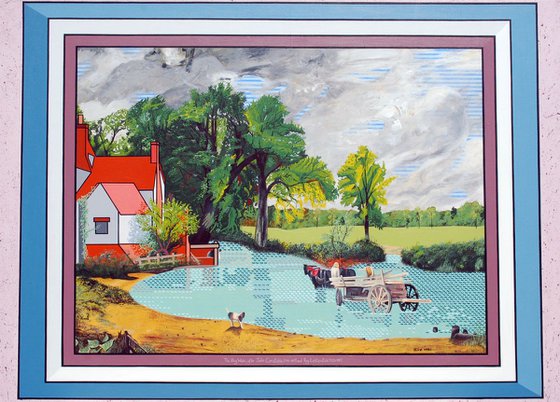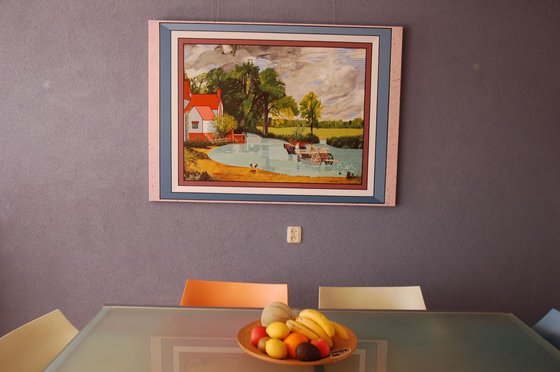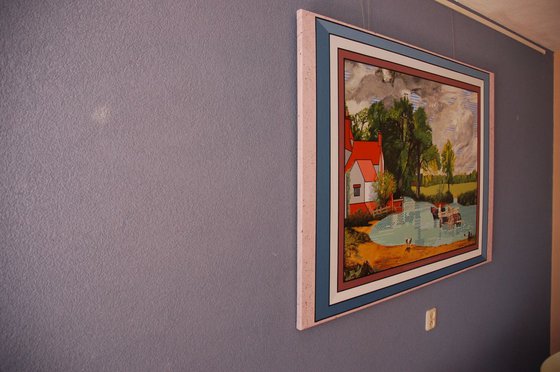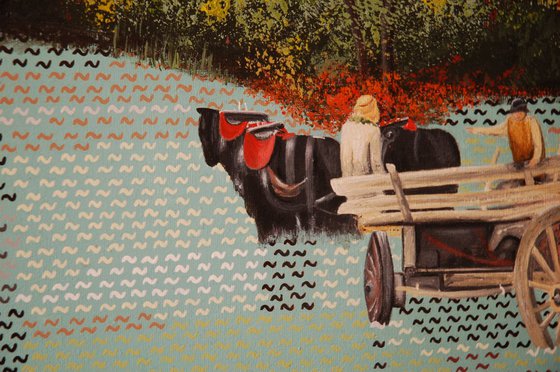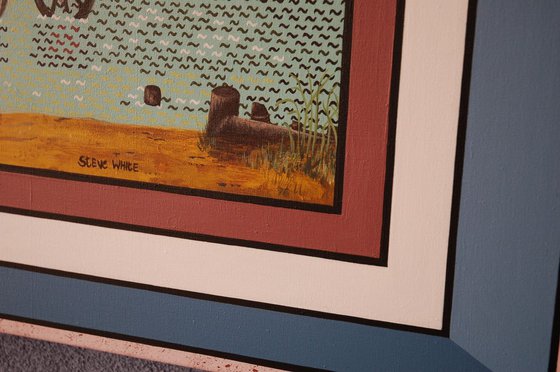- By medium
- By subject
- By budget
- Sales
- Gift cards
- Discover all art
- Artists
- Editors’ picks
- Ideas
Original artwork description:
A modicum of diligent Googling reveals that the quote 'Good artists copy, great artists steal' has been variously attributed to Apple founder Steve Jobs, Picasso, or, weirdly, Steve Jobs attributing it to Picasso. This is confusing, but, whoever said it, the history of artists 'adapting' other artists has gone on since the year dot. Duchamp put a moustache on the Mona Lisa. Roy Lichtenstein lifted pages from comic books practically dot for dot. Van Gogh copied Japanese printmaker Hiroshige. Manet 'drew inspiration' from Raphael. The list is endless. Gaugin said 'art is either plagiarism or revolution'. Let's face it, it's mostly plagiarism. There is even a legitimate name for this dubious school: Appropriation Art is the use of pre-existing objects or images with little or no transformation applied to them. One of its chief practitioners, Elaine Sturtevant, explained the philosophy, 'Remake, reuse, reassemble, recombine – that’s the way to go.'
Anyway this is my excuse for my ...er...'reassembling' of classic artists in my ingeniously titled series 'Classic Updates for the New Millennium'.
I have already 'recombined' one of the Netherland's most famous paintings. After the Rembrandt's The Night Watch and Vermeer's View of Delft, the third most popular painting in the Netherlands, according to postcard sales in the shop at the Rijksmuseum, is Jacob Isaackszoon van Ruisdael's ‘Windmill at Wijk bij Duurstede.’ Van Ruisdael, an artist of the 17th century Dutch Golden Age, specialised in typical Dutch landscapes – ie, a vertiable crepe pan of flat-earthiness interrupted by windmills and glowered over by big skies chock full of distinctive clouds. With Dutch scenery being of the distinctly minimal variety van Ruisdael thought nothing of filling 2/3 of a canvas with an interesting sky, and his depictions of clouds became so famous they became known as Ruisdael Clouds. No one outside the Netherlands who is not an interested expert has ever heard of van Ruisdael, but the image you have in your brain of a typical 17th century Dutch landscape was surely painted by him.
And where van Ruisdael went, others trod. Amongst UK artists Gainsborough, Turner and Constable were big vR fans. Constable, a fellow flat earther from Suffolk, even took his adulation as far as to paint an almost exact copy of van Ruisdael's 'Landscape with Windmills near Haarlem' almost 200 years after the original. During his lifetime Constable, the archetypical British landscape artist, was, surprisingly, never that popular in the UK, selling more pictures in France, where he inspired Delacroix, Gericault and the Barbizon School.
Pondering my next 'reassembling' of a classic painting it seemed fitting to exploit the tenuous connection between van Ruisdael and Constable. After Turner's The Fighting Temeraire, the 2nd most popular painting in the UK, according to a 2005 poll organised by BBC Radio Four's Today programme, is Constable's The Hay Wain. Everyone knows The Hay Wain - it depicts three inert nags hauling two yokels on a 'wain' (cart) across the river Stour on the Essex/Suffolk border, overlooked by tenant farmer Willy Lott's tree-framed, run down cottage (which he never left for more than 4 days in his lifetime). This is the England of warm beer, cricket on the village green and a district nurse cycling to her next appointment.
Van Ruisdael and Constable respectively captured quintessential country scenes of the 17th and 19th centuries. But we now live in the 21st century! What is the problem with titivating these crusty old images and making them relevant for the super-hip modern times we live in today? There is no problem! ('Art is anything you can get away with!' - Andy Warhol/Marshall McLuhan.)
In sprucing up The Hay Wain I would very much like to have employed some of Roy Lichtenstein's trademark dots, but making and utilising the sort of templates Roy employed was beyond my expertise, and I am not yet brain dead enough to want paint each dot individually, so I went for the easier option of using some Lichtensteinian stripes, and thick black outlines. The aim of my 're-using' these images was not to totally corrupt the original - drastically new cover versions of old songs are never as good as the original.
It' s true I' ve made the sky stripy; the water contains cartoon ripples; and Willy Lott' s cottage is a heavily outlined featureless orange box. Also the field in the background is painted in a monotone flat green, and selected shrubbery was painted with the rough side of a cheap pan scrubber from Lidl, a contrivance I doubt Constable considered. From a distance, to a blind man, the trees in my Hay Wain may look relatively authentic, but they were basically painted by numbers - there is no blending of the paint at all, just different layers of green dumbly stacked up on top of each other. The clouds were smeared onto the canvas in a mounting panic when I suddenly began to appreciate the cloud-painting skill of Constable, and especially van Ruisdael. I never wanted to copy their clouds but, still, I didn't want mine to look like some soiled, low quality pillows piled up together in a rugby scrum.
The painted 'frame' is a classic Lichtenstein device - for me it gives any painting a clean, contemporary look. And, just for the hell of it, a favourite effect of mine - the outside edge of the frame comprises two shades of violet iron oxide, the darker of which is flicked onto the lighter with a toothbrush, giving the effect of a formica table top in a cheap trucker's cafe on the A12 near Colchester.
So, the good news is that if you have ever dreamt of owning a Constable or a Lichtenstein, you can now own both! BCGLT! (Buy Constable Get Lichtenstein Too)
Next up: Jackson Pollock does Boticelli's The Birth of Venus.
Materials used:
Acrylics
Tags:
#updated classics #the hay wain #country scene #constable #roy lichtensteinThe Hay Wain, revisited. (2018) Acrylic painting
by Steve White
2 Artist Reviews
£815.6
- Acrylic painting on Canvas
- One of a kind artwork
- Size: 140 x 100 x 2cm (unframed) / 140 x 97cm (actual image size)
- Ready to hang
- Signed on the front
- Style: Graphic, illustrative and typographic
- Subject: Landscapes, sea and sky
Loading
Original artwork description
A modicum of diligent Googling reveals that the quote 'Good artists copy, great artists steal' has been variously attributed to Apple founder Steve Jobs, Picasso, or, weirdly, Steve Jobs attributing it to Picasso. This is confusing, but, whoever said it, the history of artists 'adapting' other artists has gone on since the year dot. Duchamp put a moustache on the Mona Lisa. Roy Lichtenstein lifted pages from comic books practically dot for dot. Van Gogh copied Japanese printmaker Hiroshige. Manet 'drew inspiration' from Raphael. The list is endless. Gaugin said 'art is either plagiarism or revolution'. Let's face it, it's mostly plagiarism. There is even a legitimate name for this dubious school: Appropriation Art is the use of pre-existing objects or images with little or no transformation applied to them. One of its chief practitioners, Elaine Sturtevant, explained the philosophy, 'Remake, reuse, reassemble, recombine – that’s the way to go.'
Anyway this is my excuse for my ...er...'reassembling' of classic artists in my ingeniously titled series 'Classic Updates for the New Millennium'.
I have already 'recombined' one of the Netherland's most famous paintings. After the Rembrandt's The Night Watch and Vermeer's View of Delft, the third most popular painting in the Netherlands, according to postcard sales in the shop at the Rijksmuseum, is Jacob Isaackszoon van Ruisdael's ‘Windmill at Wijk bij Duurstede.’ Van Ruisdael, an artist of the 17th century Dutch Golden Age, specialised in typical Dutch landscapes – ie, a vertiable crepe pan of flat-earthiness interrupted by windmills and glowered over by big skies chock full of distinctive clouds. With Dutch scenery being of the distinctly minimal variety van Ruisdael thought nothing of filling 2/3 of a canvas with an interesting sky, and his depictions of clouds became so famous they became known as Ruisdael Clouds. No one outside the Netherlands who is not an interested expert has ever heard of van Ruisdael, but the image you have in your brain of a typical 17th century Dutch landscape was surely painted by him.
And where van Ruisdael went, others trod. Amongst UK artists Gainsborough, Turner and Constable were big vR fans. Constable, a fellow flat earther from Suffolk, even took his adulation as far as to paint an almost exact copy of van Ruisdael's 'Landscape with Windmills near Haarlem' almost 200 years after the original. During his lifetime Constable, the archetypical British landscape artist, was, surprisingly, never that popular in the UK, selling more pictures in France, where he inspired Delacroix, Gericault and the Barbizon School.
Pondering my next 'reassembling' of a classic painting it seemed fitting to exploit the tenuous connection between van Ruisdael and Constable. After Turner's The Fighting Temeraire, the 2nd most popular painting in the UK, according to a 2005 poll organised by BBC Radio Four's Today programme, is Constable's The Hay Wain. Everyone knows The Hay Wain - it depicts three inert nags hauling two yokels on a 'wain' (cart) across the river Stour on the Essex/Suffolk border, overlooked by tenant farmer Willy Lott's tree-framed, run down cottage (which he never left for more than 4 days in his lifetime). This is the England of warm beer, cricket on the village green and a district nurse cycling to her next appointment.
Van Ruisdael and Constable respectively captured quintessential country scenes of the 17th and 19th centuries. But we now live in the 21st century! What is the problem with titivating these crusty old images and making them relevant for the super-hip modern times we live in today? There is no problem! ('Art is anything you can get away with!' - Andy Warhol/Marshall McLuhan.)
In sprucing up The Hay Wain I would very much like to have employed some of Roy Lichtenstein's trademark dots, but making and utilising the sort of templates Roy employed was beyond my expertise, and I am not yet brain dead enough to want paint each dot individually, so I went for the easier option of using some Lichtensteinian stripes, and thick black outlines. The aim of my 're-using' these images was not to totally corrupt the original - drastically new cover versions of old songs are never as good as the original.
It' s true I' ve made the sky stripy; the water contains cartoon ripples; and Willy Lott' s cottage is a heavily outlined featureless orange box. Also the field in the background is painted in a monotone flat green, and selected shrubbery was painted with the rough side of a cheap pan scrubber from Lidl, a contrivance I doubt Constable considered. From a distance, to a blind man, the trees in my Hay Wain may look relatively authentic, but they were basically painted by numbers - there is no blending of the paint at all, just different layers of green dumbly stacked up on top of each other. The clouds were smeared onto the canvas in a mounting panic when I suddenly began to appreciate the cloud-painting skill of Constable, and especially van Ruisdael. I never wanted to copy their clouds but, still, I didn't want mine to look like some soiled, low quality pillows piled up together in a rugby scrum.
The painted 'frame' is a classic Lichtenstein device - for me it gives any painting a clean, contemporary look. And, just for the hell of it, a favourite effect of mine - the outside edge of the frame comprises two shades of violet iron oxide, the darker of which is flicked onto the lighter with a toothbrush, giving the effect of a formica table top in a cheap trucker's cafe on the A12 near Colchester.
So, the good news is that if you have ever dreamt of owning a Constable or a Lichtenstein, you can now own both! BCGLT! (Buy Constable Get Lichtenstein Too)
Next up: Jackson Pollock does Boticelli's The Birth of Venus.
Materials used:
Acrylics
Tags:
#updated classics #the hay wain #country scene #constable #roy lichtenstein14 day money back guaranteeLearn more
